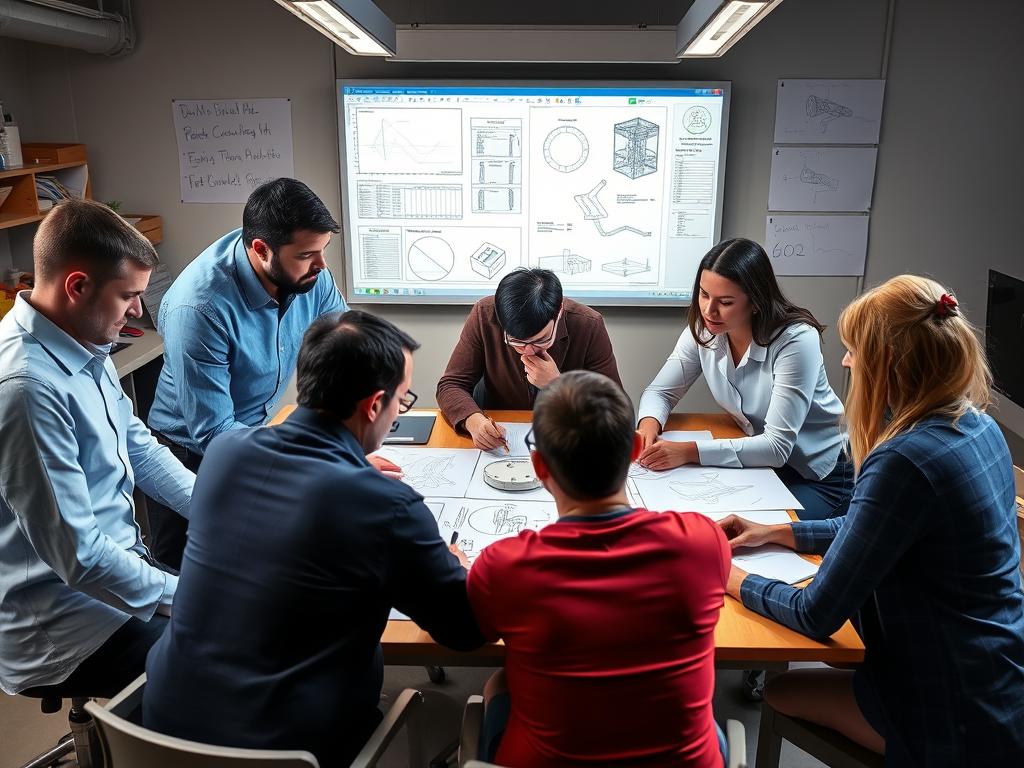Engineering stands as the cornerstone of innovation and technological advancement in our modern world. At its foundation lie core principles that guide everything from how we train new engineers to how we develop cutting-edge technologies. These principles form the backbone of engineering practice across disciplines, connecting the theoretical with the practical, the educational with the professional, and the traditional with the innovative.
In this comprehensive exploration, we’ll examine how foundational engineering principles manifest in professional training programs, contractual frameworks, and technological innovations. We’ll see how leading organizations implement these principles and how they shape the future of engineering practice in an increasingly complex global landscape.
Foundational Principles of Engineering
Engineering principles serve as the guiding framework for all engineering activities, from concept development to implementation. These principles aren’t merely theoretical constructs but practical guidelines that ensure engineering solutions are effective, safe, and sustainable.
Ethical Responsibility in Engineering Practice
Ethics forms the cornerstone of engineering practice. Engineers must prioritize public safety, welfare, and sustainable development in all their work. This ethical foundation manifests in several key principles:
- Holding paramount the safety, health, and welfare of the public
- Performing services only in areas of competence
- Issuing public statements only in an objective and truthful manner
- Acting as faithful agents for each employer or client
- Avoiding deceptive acts and conflicts of interest
- Conducting oneself honorably and improving the integrity of the profession
These ethical principles are particularly crucial in training programs where new engineers develop their professional identity and in contractual frameworks that govern engineering projects.
Systematic Problem-Solving Methodology

Engineering excellence is built upon a systematic approach to problem-solving that includes:
Problem Definition
Clearly articulating the problem, including constraints, requirements, and desired outcomes. This critical first step ensures that engineering solutions address the actual needs rather than perceived ones.
Research and Analysis
Gathering relevant data, researching existing solutions, and analyzing the problem context. This includes understanding the physical principles, economic factors, and social considerations that impact potential solutions.
Solution Development
Generating multiple potential solutions through creative thinking and technical knowledge. This phase often involves collaboration across disciplines to develop innovative approaches.
Evaluation and Selection
Assessing potential solutions against established criteria and selecting the most promising approach. This evaluation considers technical feasibility, economic viability, and alignment with project requirements.
Implementation
Executing the selected solution through detailed design, testing, and deployment. This phase transforms theoretical concepts into practical applications.
Validation and Iteration
Testing the implemented solution against requirements and refining as necessary. This iterative process ensures continuous improvement and adaptation to changing conditions.
Master Engineering Problem-Solving
Download our comprehensive guide to engineering problem-solving methodologies and enhance your technical capabilities.
Sustainability and Life-Cycle Thinking
Modern engineering principles increasingly emphasize sustainability throughout the entire life cycle of products, systems, and structures. This includes:
- Resource efficiency in design and manufacturing
- Energy optimization during operational life
- Minimization of environmental impact
- Design for disassembly and recyclability
- Consideration of social and economic sustainability
These sustainability principles are now integrated into engineering training programs and contractual frameworks, reflecting their growing importance in professional practice.
Practical Applications of Engineering Principles
The theoretical principles of engineering find practical expression in various professional contexts, from contractual frameworks to training programs. These applications demonstrate how engineering principles adapt to different environments while maintaining their core integrity.
New Engineering Contract (NEC) Frameworks

The New Engineering Contract (NEC) represents a modern approach to engineering project management that embodies core engineering principles in contractual form. Key aspects include:
| NEC Principle | Engineering Principle Connection | Practical Implementation |
| Mutual Trust and Cooperation | Ethical responsibility and collaborative problem-solving | Open communication channels and joint risk management |
| Clear Roles and Responsibilities | Systematic methodology and accountability | Defined project management structure with clear authority lines |
| Risk Management | Analytical problem-solving and preventive thinking | Early warning systems and shared risk registers |
| Flexibility and Adaptability | Iterative design and continuous improvement | Compensation events and change management procedures |
| Integrated Project Planning | Systems thinking and life-cycle approach | Collaborative schedules and resource planning |
The NEC framework demonstrates how engineering principles can be codified into contractual relationships, ensuring that projects are delivered according to best practices while maintaining flexibility for innovation.
Summer Trainee Engineering Program Structures

Summer trainee engineering programs represent a critical bridge between academic learning and professional practice. These programs embody engineering principles through structured learning experiences:
Technical Skill Development
- Hands-on application of theoretical concepts
- Exposure to industry-standard tools and software
- Technical problem-solving in real-world contexts
- Documentation and technical communication practice
Professional Development
- Ethical decision-making scenarios
- Team collaboration and project management
- Client interaction and requirement gathering
- Presentation and communication skills
Effective summer trainee programs integrate core engineering principles through a combination of structured learning, mentorship, and practical project work. These programs often culminate in capstone projects that require trainees to apply multiple engineering principles to solve complex problems.
Enhance Your Engineering Training Program
Request a consultation with our engineering education specialists to optimize your trainee program structure.
Probationary Engineer Skill Development Paths

The transition from graduate to professional engineer typically involves a probationary period where new engineers develop essential skills under supervision. These development paths systematically build competence in core engineering principles:
Technical Competence Development
Probationary engineers progressively develop technical skills through increasingly complex assignments. Beginning with well-defined problems under close supervision, they gradually tackle more ambiguous challenges with greater autonomy. This progression reinforces systematic problem-solving principles while building technical confidence.
Professional Judgment Formation
Engineering judgment—the ability to make sound decisions with incomplete information—develops through guided experience. Probationary engineers learn to balance theoretical ideals with practical constraints, applying ethical principles to real-world situations under the guidance of experienced mentors.
Interdisciplinary Collaboration
Modern engineering requires collaboration across disciplines. Probationary development paths often include rotations through different departments or project teams, helping new engineers understand how their specialized knowledge connects with broader systems and other technical domains.
Well-structured probationary programs integrate formal training with experiential learning, ensuring that new engineers internalize core principles while developing practical skills. These programs typically include regular assessment against competency frameworks aligned with engineering principles.
Organizational Implementation of Engineering Principles
Leading engineering organizations distinguish themselves through how they implement and extend core engineering principles. Their approaches offer valuable insights into effective engineering practice at scale.
Engineering Consultants Group: Principle-Based Project Delivery

Engineering Consultants Group exemplifies how engineering principles can be systematically implemented across diverse projects. Their approach includes:
- Knowledge Management Systems that capture and disseminate engineering principles across the organization
- Standardized Methodologies that ensure consistent application of principles while allowing for project-specific adaptation
- Cross-Disciplinary Review Processes that validate solutions against multiple engineering perspectives
- Client Education Initiatives that help clients understand the engineering principles guiding project decisions
This systematic approach enables Engineering Consultants Group to maintain consistency across projects while fostering innovation through controlled adaptation of principles to new contexts.
Jacob Engineering Group: Principles in Global Operations

Jacob Engineering Group demonstrates how engineering principles can be maintained across global operations spanning diverse cultural and regulatory environments. Key aspects of their approach include:
Strengths of Global Implementation
- Centralized principle documentation with local adaptation guidelines
- Global communities of practice that share principle applications
- Standardized tools that embed engineering principles in workflows
- Cross-regional project teams that blend diverse perspectives
Challenges in Global Implementation
- Varying regulatory requirements across jurisdictions
- Cultural differences in risk perception and management
- Communication barriers in principle interpretation
- Balancing global standards with local practices
Jacob Engineering Group’s approach demonstrates how engineering principles can provide a unifying framework across diverse operating environments while allowing for necessary adaptation to local conditions.
Implement Engineering Principles in Your Organization
Register for our upcoming webinar on organizational implementation of engineering principles featuring experts from leading engineering firms.
Engineering Principles in Advanced Technologies
Engineering principles find their most innovative expressions in advanced technologies that push the boundaries of what’s possible. These technologies demonstrate how fundamental principles adapt to new contexts while maintaining their essential character.
Laser Engineered Net Shaping (LENS): A Case Study in Innovation

Laser Engineered Net Shaping (LENS) represents a cutting-edge application of engineering principles in advanced manufacturing. This additive manufacturing technology uses high-powered lasers to fuse metal powders into complex three-dimensional structures with exceptional precision.
Technical Foundations of LENS Technology
LENS technology embodies multiple engineering principles in its operation:
| Engineering Principle | LENS Implementation | Resulting Capability |
| Thermodynamics | Precise control of laser energy to create localized melt pools | Ability to process high-temperature materials with minimal heat-affected zones |
| Materials Science | Controlled solidification of metal powders to achieve desired microstructures | Creation of components with tailored material properties and functionally graded materials |
| Control Systems | Real-time feedback loops that adjust laser parameters based on melt pool characteristics | Consistent material deposition regardless of geometry complexity |
| Computer-Aided Design | Direct translation of 3D models to machine paths without tooling | Rapid production of complex geometries impossible with traditional manufacturing |

Applications and Implications
LENS technology demonstrates how engineering principles enable revolutionary capabilities:
- Aerospace Components with optimized internal structures that reduce weight while maintaining strength
- Medical Implants with biocompatible surfaces and patient-specific geometries
- Rapid Prototyping of functional metal components for testing and validation
- Repair and Refurbishment of high-value components through targeted material addition
- Multi-Material Structures with gradual transitions between different alloys
The development and application of LENS technology illustrate how engineering principles provide the foundation for technological innovation while adapting to new possibilities and requirements.
“LENS technology represents the perfect marriage of fundamental engineering principles with cutting-edge capabilities. It demonstrates how core principles like thermodynamics and materials science can be applied in novel ways to create previously impossible manufacturing capabilities.”
The Future of Engineering Principles

Engineering principles continue to evolve in response to changing technological capabilities, societal needs, and global challenges. Several key trends are shaping the future direction of engineering principles:
Integration of Artificial Intelligence
Artificial intelligence is transforming how engineering principles are applied, enabling:
- Generative design that explores solution spaces beyond human intuition
- Predictive maintenance that anticipates failures before they occur
- Automated optimization that balances multiple competing objectives
- Knowledge systems that capture and apply engineering expertise
These AI capabilities don’t replace fundamental engineering principles but rather extend their application to more complex problems and larger solution spaces.
Sustainability as a Core Principle

Sustainability is evolving from a specialized consideration to a fundamental engineering principle that informs all aspects of engineering practice:
Circular Economy Design
Engineering principles now increasingly incorporate circular economy thinking, designing products and systems for multiple life cycles rather than single use. This approach minimizes waste and maximizes resource efficiency.
Carbon-Conscious Engineering
Carbon footprint analysis is becoming integrated into core engineering principles, with carbon impact considered alongside traditional metrics like cost, performance, and reliability in decision-making processes.
Biomimicry
Engineering principles increasingly draw inspiration from natural systems, which have evolved highly efficient and sustainable solutions to complex problems. This approach connects engineering with biological principles.
Social Sustainability
Engineering principles are expanding to consider social impacts more explicitly, ensuring that solutions are not only technically sound but also socially beneficial and equitable in their effects.
Interdisciplinary Integration
The boundaries between traditional engineering disciplines are blurring, leading to more integrated principles that span multiple domains:
- Mechatronics principles that combine mechanical, electrical, and software engineering
- Bioengineering approaches that merge biological sciences with engineering methodologies
- Socio-technical systems thinking that integrates social and technical considerations
- Digital twin concepts that link physical and virtual representations of engineered systems
This interdisciplinary integration creates more holistic engineering principles that better address complex real-world challenges.
Conclusion: The Interconnected Nature of Engineering Principles
Engineering principles form a cohesive framework that connects all aspects of engineering practice, from education and training to professional practice and technological innovation. These principles provide continuity across the engineering lifecycle while adapting to new challenges and opportunities.
The integration of engineering principles in training programs, contractual frameworks, organizational practices, and technological innovations demonstrates their enduring value and adaptability. As we’ve seen through examples like summer trainee programs, the New Engineering Contract, and Laser Engineered Net Shaping technology, these principles provide both stability and flexibility.
Looking forward, engineering principles will continue to evolve in response to changing technological capabilities and societal needs. The increasing integration of artificial intelligence, emphasis on sustainability, and blurring of disciplinary boundaries will reshape how these principles are applied while maintaining their essential character.
By understanding and implementing core engineering principles across all aspects of engineering practice, organizations and individuals can ensure that engineering continues to advance human welfare through innovative, ethical, and sustainable solutions to global challenges.
Advance Your Engineering Knowledge
Contact us for personalized consultation on implementing engineering principles in your organization or project.
